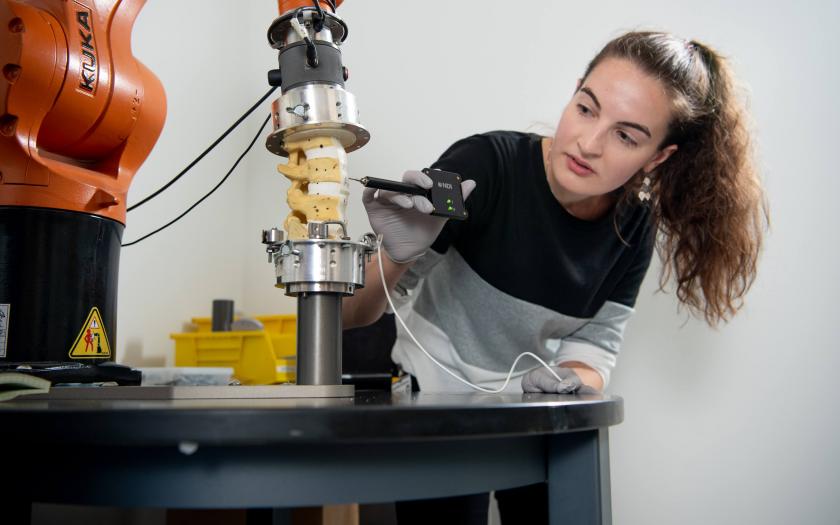Brown BME Spotlight: Josephine Kalshoven, Ph.D. Candidate

Josephine Kalshoven is a fifth-year Ph.D. student in Brown’s Biomedical Engineering program and a member of Dr. Joseph Crisco’s Lab.
Josephine Kalshoven is a fifth-year Ph.D. student in Brown’s Biomedical Engineering program and a member of Dr. Joseph Crisco’s Lab.
She received her BE in Bioengineering Sciences from the Thayer School of Engineering at Dartmouth in 2019. As an undergraduate, she worked on knee implants. Now, she mainly researches and works on the biomechanics of the thumb joint, specifically the metacarpal joint. She puts cadavers into a robotic system—moving the thumb to understand the six degrees of freedom.
The thumb joint is a common site for osteoarthritis. We don’t yet have any good implants or surgical procedures for this site. Josephine aims to target and fill this need.
Let’s learn more about Josephine from Josephine herself…
What motivated you to choose Brown University for your doctoral studies?
My advisor attracted me to Brown—the research opportunities were promising.
My decision point for ultimately selecting Brown was the people I met in the interviews. They are not only intelligent and incredible scientists, but they are friendly and welcoming. The people were curious about me, about their work, and about my work, “...which got me excited…that really was the difference between Brown and the other schools I interviewed at.”
I immediately realized that this was the place I wanted to be for graduate school.
Brown University is known for its flexible interdisciplinary approach. What’s your experience collaborating with researchers from outside your lab? Can you give an example?
I had a lot of experience at the start of my degree. The project I was focusing on was an instrumented replacement trapezium bone for the thumb. This focus meant working with electronics design, machine learning, and—at the beginning—analytical modeling of the system as I tried to figure out if we could compute the six degrees of freedom.
The first thing that I did was meet Kenny Breuer in the School of Engineering. I asked him for advice in calculating some mechanics of the design. During our meeting, he wrote three to five pages of math for me, “It was just incredible…I was like, ‘Oh my…you didn’t have to do that!’” Kenny reassured me that he loves to do this type of work with students. It was a warm welcome to Brown.
I appreciate the interdisciplinary classes: “Brown saying, ‘you can take pretty much anything’...if I hadn’t taken a machine learning class…if I hadn’t taken an electronics class…I wouldn’t be where I am today. Those classes are what helped me in the development of the device in my research.”
I also work with the clinicians. One of the professors in the Medical School is on my committee. He is an orthopedic surgeon. Our collaboration is vital to my understanding of thumb biomechanics—what ligaments contribute to which aspects of this motion
Who has played a significant role in shaping your academic journey?
My PI, Dr. Joseph Crisco–as well as other faculty member, like Dr. Vikas Srivastava and Dr. Diane Hoffman-Kim–have shaped my academic journey. The senior Ph.D. students in the program also have a big impact: “...the students who are ahead of me in the program…individuals that I could watch go through the whole experience and who could give me advice and thoughts…like Amanda Khoo, Bardiya Akhbari, and Sean Flannery…they are three friends who are inspirational role models, academically and otherwise.”
What do you like to do outside the lab?
I’m involved in a lot of academic extracurriculars. I work with the technology transfer office—looking at the technology coming out of Brown and helping figure out how we commercialize it. I work closely with the Brown-RISD Catholic Centre—organizing events, studies, and discussions. I’m on the Graduate Student Council where I plan gatherings and meetings with faculty. In my free time, I enjoy time with friends and creative writing, music, and acting.
What question do you wish we had asked?
I’m reflecting on the personal growth I experienced during my Ph.D.: “My family and friends knew me as a person who was terrified of skeletons…terrified of human anatomy, in general…Now, I am working with cadavers…when I work with hands, I think to myself, ‘I’ll be the last person to hold this person’s hands…’” This newfound approach and level of respect provide a whole different perspective on my research—elevating the level of everything that I do.
Also, as a senior Ph.D. student, I want to offer advice to incoming students. One of the biggest pieces of advice for students considering certain labs: make sure that you know your advisor. I feel like an advisor can either make or break your experience. Look at their research. Look at who you may be working with and how they work—the labmates and their culture. What’s the best fit for you? And I recommend students start building community as early as possible—make friends with the older students. At Brown, they want to guide you and support you.